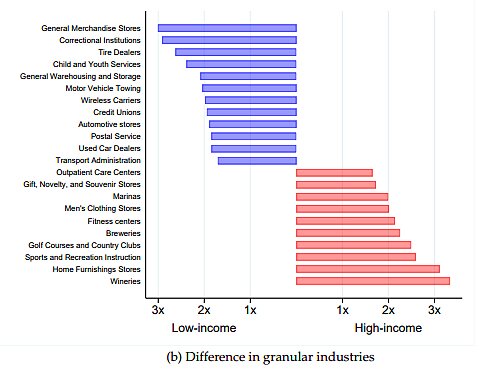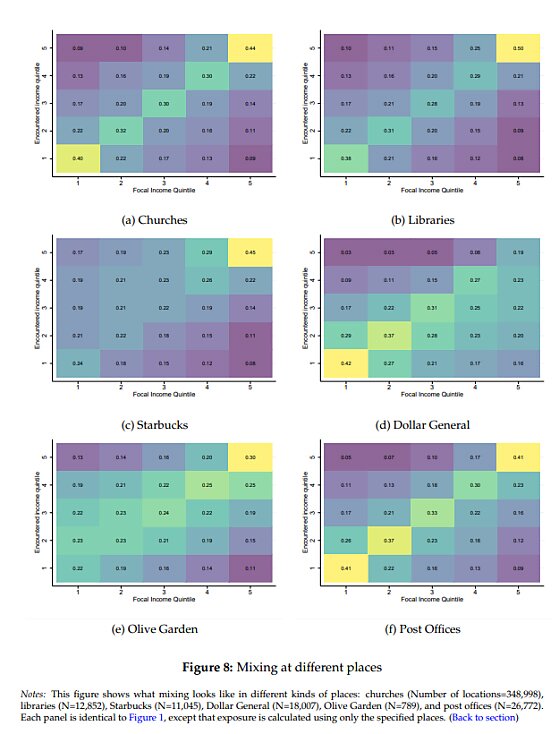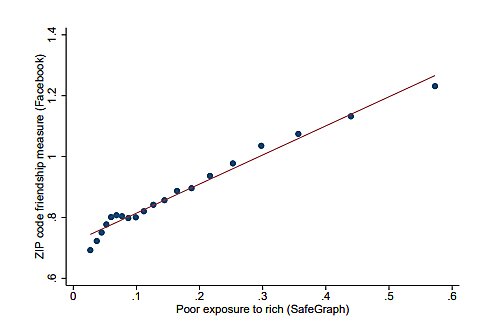Based on these other robustness checks, they conclude that “cross-class friendships … and cross-class interactions remain closely linked.”
And, to recap, chains are where cross-class interactions happen most.
Okay, Fine, So What?
None of this means, of course, that subsidizing Chili’s or whatever will solve America’s social cohesion issues. And pubs and cafes have long served as “social mixing” places—something that’s not just a TV cliché but also recently confirmed by other research on the issue (cool interactive map here, by the way). So, sure, some of this isn’t exactly a revelation.
But the findings here, assuming they’re legit, still matter for several reasons.
Most obviously, there’s been a lot of ink spilled in recent years on how “third places”—neutral places outside the home and workplace where people are more likely to interact—are important for social harmony and equality and thus in need of government support. Yet most policy proposals in this regard target the typical “communitarian” establishments—public (parks, museums, libraries, etc.) and private (churches, civic organizations, etc.)—while ignoring or even denigrating the big commercial places that, it turns out, are quietly mixing rich and poor Americans best. Even worse, many localities have gone so far as to ban “big box” retailers and chain restaurants on expressly communitarian grounds (though perhaps this trend is changing).
To the extent policymakers do want to boost other types of third places, moreover, they’ll need to address residential segregation—and the policies driving some of it. This includes, especially, restrictive zoning policies that build high walls around affluent neighborhoods and public-school systems that encourage the wealthy to pay to get inside those walls (because that’s where the “good schools” are).
Time for a policy rethink, communitarians.
Second, these findings are a pretty clear strike against the trendy anti-corporate rhetoric from populists on the left and (especially these days) the right. We’re constantly told, for example, how “rampant consumerism” destroys our communities and increases isolation. Yet the places in America today that, for better or worse, are actually the most open and socioeconomically diverse—thanks to their affordability, consistency, and commonness (yay, capitalism)—are the places these and other critics are most likely to denigrate. Preferred alternatives, meanwhile, provide fewer opportunities for cross-class connection and can even boost isolation. Thus, contrary to what you might read, “bougie” consumerism and community are not mutually exclusive. And efforts to restrict or destroy the much-derided icons of American mass consumption—both the companies and the policies that support them—could undermine the very cross-class community bonds that so many critics of modern capitalism claim to champion.
Finally, there’s something remarkable that, for all the talk about skyrocketing economic inequality in the United States, the findings show again that there’s been a great leveling of American society in terms of what we consume and where we consume it. Yes, of course, we remain an unequal society in lots of ways (mostly for the better, IMO), and the super rich among us on their yachts and spaceships probably aren’t getting their pancakes at IHOP. But there’s far more intermingling of America’s regular-old rich and its poor—dining at the same places and buying/using the same stuff—than there was back in the good ol’ days before the Great Enrichment. And we have ubiquitous, cheap, tasty stuff to thank for some of that.
So go ahead and pass the properly constructed nachos, friends. You may be doing society a favor when you do.
Chart of the Week
Immigrants have founded a lot of billion-dollar U.S. companies








